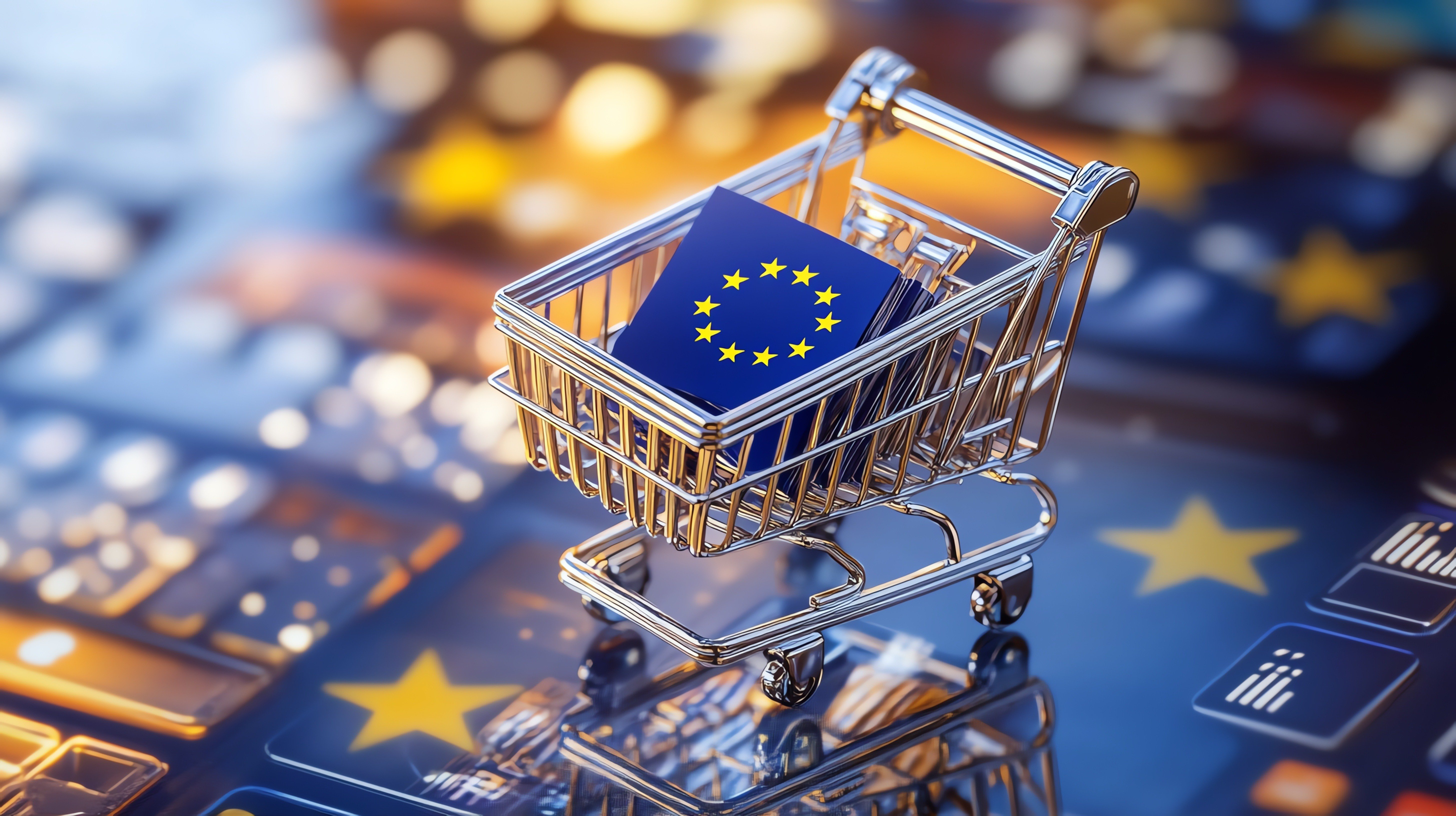Đọc bản tiếng Việt của bài viết tại đây.
The European Union (EU) represents a vast and diverse market for print-on-demand (POD) businesses, making it an exciting yet nuanced region for international sellers. While the EU’s e-commerce landscape has traditionally lagged slightly behind the US, recent shifts indicate that it’s rapidly catching up, presenting lucrative opportunities for online sellers. In this post, we’ll explore EU consumer characteristics, current e-commerce trends with data-backed insights, and unique holiday celebrations to help sellers effectively target the European market.
Characteristics of EU Consumers: What Sets Them Apart?
The EU consumer market is incredibly diverse, with unique cultural nuances influencing purchasing decisions. Understanding these differences can help POD sellers tailor their products and marketing strategies to suit each region. Here’s a deeper dive into key characteristics:
Diverse Cultural Preferences

Each EU country has specific cultural influences that shape consumer tastes. Italian consumers, for example, often seek stylish, fashion-forward items reflecting Italy's rich design heritage. Products that blend functionality with aesthetic appeal tend to perform well here. Meanwhile, consumers in the Nordic countries—like Sweden, Denmark, and Norway—embrace minimalist and functional designs, reflecting the Scandinavian ethos of “less is more.” Marketing efforts highlighting simplicity, functionality, and environmental benefits will likely resonate with these audiences.
For a deeper dive into culture and consumer behavior, the following resources can be good starting points with valuable insights:
- European Consumer Reports and Studies: Eurostat and Statista regularly publish studies on European consumer behavior, offering insights into spending habits, preferences, and demographic data across EU countries. These reports help break down market-specific tendencies and current trends in consumer expectations.
- E-commerce Europe’s Annual Reports: E-commerce Europe publishes detailed annual reports on the EU’s e-commerce landscape, including country-specific insights. These reports can be beneficial for understanding consumer preferences, popular payment methods, and e-commerce trends.
- Country-specific Chambers of Commerce Websites: Many EU countries have chambers of commerce that offer insights and resources for understanding local markets. Websites like the French Chamber of Commerce (CCI France), the German Chamber of Commerce (AHK), and others often provide data on local consumer preferences, spending habits, and cultural considerations.
Growing Interest in Localized and Personalized Products
Localization is essential for success in the EU. According to a CSA Research study, 76 percent of online shoppers prefer to buy products with information in their native language. In addition, 40 percent will never buy from websites in other languages. For print-on-demand sellers, offering options in local languages and incorporating local cultural symbols can significantly improve engagement and conversion rates. Additionally, personalizing products—such as custom mugs, t-shirts, and home decor that reflect local idioms, names, or regional pride—can appeal strongly to the consumer’s desire for uniqueness.
High Demand for Sustainability
European consumers are increasingly concerned about the environmental impact of their consumption habits, making way for laws and policies that encourage sustainability across Europe. While the sweeping legislation can make Europe’s green segments look homogeneous, consumer behaviors and attitudes often vary between countries. A Forrester study examined the greenness of EU consumers and revealed the following:
- Italian consumers are among the greenest, with the highest percentage of Active Greens and the lowest percentage of Non-Greens, followed by Spain and France.
- Spanish consumers are enthusiastic about green products. They are the most likely among the five largest European economies to be willing to pay more for environmentally friendly products. A majority would like to understand how their purchases impact the environment and feel disappointed when they find out packaging isn’t recyclable or compostable.
- French consumers are more likely to be Dormant Greens. While French online adults are primarily Dormant Greens, only one in five French online adults think that reducing their environmental impact is too much work.
- German and UK consumers’ green behaviors and attitudes lag. Germany has the highest percentage of Non-Greens and the second-lowest percentage of Active Greens after the UK. While brands that engage with UK consumers shouldn’t ignore green solutions, they must be aware of local behaviors and attitudes. UK consumers are the most likely to agree that they prefer cheaper products to environmentally friendly ones.
Forrester’s research also revealed unexpected correlations between age and green behaviors in Europe, where sustainability concerns rank higher on political and social agendas.
- While businesses and the media tend to typecast Gen Z (born between 1997 and 2012) as the sustainability generation, the report shows they are not the most actively green generation. Gen Zers value environmental awareness but expect seamless, instant experiences; they demand sustainable products but are the prime buyers of fast fashion, and they’re most likely to agree that a low-cost or convenient product is more valuable to them than an eco-friendly one.
- More among the older generations tend to be Active Greens rather than Convenient Greens. While older generations also contain more Non-Greens, the key difference is the distribution between Active and Convenient Greens. The percentage of Active Greens among the Silent Generation is significantly higher than among Gen Zers. A large part of this can be explained by the fact that older generations have the time and money to act on the values that their children and grandchildren have instilled in them.
The EU’s consumer expectations offer a unique advantage for POD sellers who use environmentally conscious materials or offer sustainable packaging. Emphasizing the eco-friendliness of products in product descriptions and marketing campaigns can build trust and loyalty among EU buyers. However, the amount of emphasis on these factors largely depends on the target demographic.
Price Sensitivity vs. Value Perception
While European consumers tend to be value-conscious, there’s a marked appreciation for quality and durability over mere affordability. In Germany, for example, shoppers prefer items they view as investments rather than one-time purchases. Consequently, POD businesses can capitalize by focusing on high-quality designs, premium materials, and durable product options, promoting them as long-lasting choices that justify a slightly higher price point.
The Evolving E-commerce Landscape of the EU

Although the United Kingdom officially left the European Union in 2020, the Single Market’s digital economy continues to thrive and remains the powerhouse of European e-commerce. Both internet and e-shopper penetration continue to rise, and E-GDP has remained steady, with an expected increase in 2024.
- In 2024, 93 percent of the population aged 16-74 accessed the internet, compared to 87 percent in 2019 (source: Eurostat, Datareportal, Statista, National Statistical Offices).
- In 2024, 71 percent of the population aged 16-74 bought goods or services online, compared to 60 percent in 2019 (source: Eurostat, Statista, National Statistical Offices).
- In 2023, online purchasing nationally and cross-border as a share of the EU’s overall online purchases were 83 percent from national sellers, 33 percent from sellers in other EU countries, and 20 percent from sellers of the rest of the world (source: Eurostat).
Among the EU nations, the following are considered among the more established markets:
- Germany can be considered an economic titan within Europe. Its consumers are known to prefer quality, efficiency, and reliability in online shopping. The German market is highly competitive, requiring businesses to offer high-quality services and products.
Population in 2024: 84,552,242
Projected market volume by 2028: US$131,941.6 million
- France’s robust e-commerce sector is partly thanks to a solid digital infrastructure and an affluent consumer base. French consumers have a growing appetite for online shopping, placing value on luxury and high-quality products
Population: 66,548,530
Projected market volume by 2028: US$83,944.3 million
- Spain's online market has shown significant growth, offering plenty of opportunities for e-commerce businesses in areas like fashion, home goods, and electronics.
Population: 47,910,526
Projected market volume by 2028: US$52,455.7 million
Among smaller markets, the following countries offer plenty of potential for ecommerce growth
- Poland has a rapidly growing economy with an increasing internet penetration rate. Companies entering the Polish market can benefit significantly from its large population of tech-savvy youth.
Population: 38,539,201
Projected market volume by 2028: US$40,886.4 million
- Sweden's market stands out with its high standard of living, tech literacy, and sustainability awareness. This e-commerce landscape demands high-quality services and products to captivate the discerning Swedish shopper.
Population: 10,606,999
Projected market volume by 2028: US$16,136.6 million
- Italy is in the midst of a digital renaissance. Its growing rate of internet penetration and digital literacy means the Italian market is ripe for e-commerce expansion.
Population: 59,342,867
Projected market volume by 2028: US$53,832.8 million
Leveraging Mother’s and Father’s Day Celebrations for Year-Round Marketing

Mother’s and Father’s Day celebrations vary widely across Europe, providing a unique opportunity for POD sellers to capitalize on these holidays at different times throughout the year. Here’s an in-depth look at how to approach these holidays effectively:
Mother’s Day Marketing by Region
Mother’s Day in Europe spans from March to May, depending on the country. The UK, for example, celebrates “Mothering Sunday” in March, distinct from the May dates common in other parts of Europe. Spain observes it on the first Sunday in May, while France celebrates on the last Sunday of May. This spread enables businesses to create targeted, region-specific campaigns tailored to each holiday.
Popular Mother’s Day gifts include personalized jewelry, wall photos, and sentimental gifts. Offering personalization options that allow customers to add their mother’s name or favorite quote can make the gift more meaningful.
Father’s Day Campaigns Across the EU
Father’s Day celebrations also vary, with Germany celebrating on Ascension Day in May, marking it as a public holiday. Meanwhile, the UK, France, and several other European nations celebrate Father’s Day in June. Recognizing these date differences can help print-on-demand sellers run holiday promotions and campaigns on a rolling basis, keeping Father’s Day promotions relevant across multiple months.
For popular Father’s Day gifts, consider products like custom t-shirts with regional designs, personalized mugs, socks, and even tech accessories. Products that reflect a humorous or personalized touch, such as “Best Dad” in local languages, can better appeal to more specific audiences.
Unique Regional Variations
In addition to Mother’s and Father’s Days, some European countries observe unique family-related holidays. For instance, Finland celebrates “Day of the Finnish Family” on the second Sunday of May, a day dedicated to honoring all family members. POD sellers can leverage such unique days with family-oriented products like matching family T-shirts, mugs, or even custom home decor that celebrates family pride.
Maximizing Print-on-Demand Success in the EU
The EU’s e-commerce landscape is ripe with opportunities for POD sellers who understand the nuances of its diverse consumer base. By leveraging data-backed insights on growth trends, platform preferences, and consumer expectations, POD businesses can optimize their offerings to resonate with European shoppers. Whether through customized holiday marketing for Mother’s and Father’s Days or by adapting to regional tastes, the EU offers ample room for growth and customer loyalty.
As your POD business expands into the EU, use these insights to shape your marketing strategies, and consider the unique characteristics and preferences of EU consumers. The EU may differ from other markets, but with the right approach, it’s a profitable and exciting region for sellers to explore.
For personalized guidance or support, visit our Facebook group and subscribe to our newsletter.
Happy selling!
💰 Free 7-day trial of Dreamship Plus: https://drm.sh/848d
